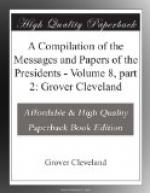Between these and the other mountains there is evidently no connection, and the rest of the country, as seen from the hill, bears the aspect of a wooded plain. It will be sufficient to refer to this view to be satisfied that all the impressions which have been circulated of a continuous chain of elevations extending along the line claimed by Great Britain are utterly fallacious.
Toward the north the country exhibits the same general features. One vast and apparently unbroken plain extends to the utmost limits of the visible horizon. In the midst of this, and at a distance of nearly 30 miles, Mars Hill alone breaks the monotonous prospect, and from its isolated position assumes to the eye an importance to which its altitude of less than 1,800 feet would not otherwise entitle it. No other eminences are to be seen in this direction, except a round peak bearing a few degrees west of north and some distant ridges about an equal distance to the east. The first of these has been ascertained by the surveys of Major Graham to be an isolated hill near the peak known as Quaquajo. The eastern ridges are probably those measured between the Tobique and the Bay of Chaleurs by the British commissioners. A sketch of this view from Parks Hill is annexed to the report, and lest any doubt be entertained of its accuracy it is proper to state that the unassisted vision was not relied upon, but that the outlines were carefully delineated by means of the camera lucida.
From this view it might be inferred that the northern part of the admitted possessions of the United States to the east of the Penobscot and the disputed territory as far as visible constitute a vast table-land slightly inclined toward the southeast.
On descending into the valley of the St. John the appearances change. The tableland is cut to a great depth by that stream, and from its bed the broken edges of the great plain look like ridges whose height is exaggerated to the senses in consequence of their being densely clothed with wood. The same is the case with all the branches of this river, which also cut the table-land to greater or less depths according to their distance from the stream into which they discharge themselves.




